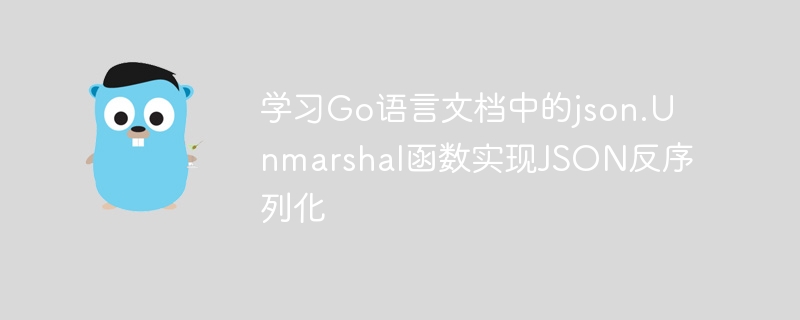

Learn the json.Unmarshal function in the Go language document to implement JSON deserialization
In the Go language, serialization and deserialization are very common operations. Deserialization is the process of converting JSON data into structures or other data types in the Go language, while serialization is the process of converting data types in the Go language into JSON strings. The standard library of the Go language provides a wealth of functions and methods to perform JSON serialization and deserialization operations. Among them, the json.Unmarshal function is one of the important functions used to implement JSON deserialization.
json.Unmarshal function is defined as follows:
func Unmarshal(data []byte, v interface{}) error
This function accepts two parameters, the first parameter is a Byte slice, that is, the JSON data to be deserialized; the second parameter is an empty interface variable used to receive deserialized data. The return value of this function is an error. If the deserialization is successful, nil is returned. If the deserialization fails, the corresponding error message is returned.
The following is a specific code example that demonstrates how to use the json.Unmarshal function to deserialize JSON:
package main
import (
"encoding/json" "fmt"
)
type Person struct {
Name string `json:"name"` Age int `json:"age"`
}
func main() {
jsonData := []byte(`{"name":"Alice","age":25}`)
var p Person
err := json.Unmarshal(jsonData, &p)
if err != nil {
fmt.Println("JSON反序列化失败:", err)
return
}
// 打印反序列化后的结果
fmt.Println("姓名:", p.Name)
fmt.Println("年龄:", p.Age)}
In the above code , first defines a structure Person, which has two fields Name and Age. Next, create a byte slice named jsonData in the main function to store the JSON data to be deserialized. Then, declare a variable p of type Person to receive the deserialized data. Then, call the json.Unmarshal function to deserialize jsonData and store the result in the variable p.
Finally, verify whether the deserialization result is correct by printing the Name and Age fields of p.
It should be noted that the tags json:"name" and json:"age" are added to the fields of the structure. The purpose of these tags is to provide a more flexible mapping relationship for field names during deserialization. If the field names of the JSON data are consistent with the field names of the structure, these tags can be omitted.
Summary:
With the help of the json.Unmarshal function provided by the standard library of the Go language, we can easily implement the deserialization operation of JSON. By instantiating a structure corresponding to JSON data and calling the json.Unmarshal function to read the JSON data into the corresponding fields in the structure, we can get a deserialized Go language object. The deserialized object can directly use the structure field to access the value in the JSON data, providing a convenient operation method.
The above is the detailed content of Learn the json.Unmarshal function in Go language documentation to implement JSON deserialization. For more information, please follow other related articles on the PHP Chinese website!




